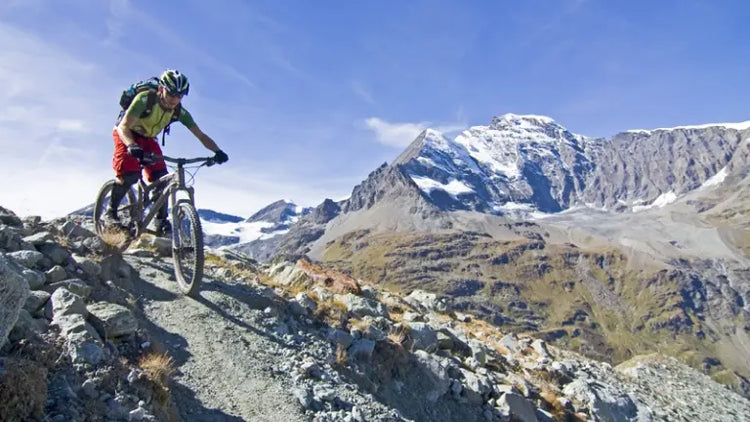Winter cycling in the Valais region offers unique experiences and rewards, from the sunny plateaus of Crans-Montana to the valley routes along the Rhône. While many cyclists store their bikes away during winter, continuing to ride can maintain your fitness, boost your mental well-being, and provide an exhilarating way to experience the stunning Alpine winter landscape.
Many cyclists in our region hesitate to ride in winter, concerned about safety, comfort, and equipment maintenance. However, with proper knowledge and preparation, winter cycling in the Valais can be both enjoyable and safe. This guide will help you understand and overcome common winter cycling challenges while maintaining your cycling routine throughout the colder months.
Understanding Valais Winter Weather Conditions
The Valais region presents various cycling conditions, from sunny valley rides to challenging mountain routes. Understanding these conditions is crucial for safe winter riding:
Temperature Considerations:
- Valley temperatures often differ significantly from mountain conditions (up to 5-8°C difference)
- Strong valley winds (especially around Martigny) can make temperatures feel significantly colder
- Temperature inversions common in the Rhône Valley - often warmer at altitude
- Significant temperature variations between morning valley fog and afternoon sun
Road Conditions:
- Black ice commonly forms in shaded valley sections, especially near Sierre and Sion
- Snow clearing varies between main routes and secondary roads
- Salt treatment on main roads affects visibility and bike components
- Watch for ice formation near water crossings and bridges over the Rhône
Visibility Factors:
- Valley fog common in winter mornings, especially between Sierre and Martigny
- Low winter sun reflection from snow can affect visibility
- Short daylight hours
- Clear mountain air can deceive distance perception
Essential Safety Tips for Alpine Region
Safety becomes even more critical during Valais winters. Following these guidelines helps ensure a secure riding experience:
Visibility Strategies:
- Choose riding times after morning fog has cleared
- Use multiple light sources - crucial in frequent tunnel sections
- Position lights for maximum visibility in varying light conditions
- Wear clothing with reflective elements visible from all angles
Winter Road Positioning:
- Take primary position when necessary, especially in tunnels
- Maintain greater distances on mountain descents
- Stay visible on winding valley roads
- Avoid road edges where snow melt creates ice patches
Braking Techniques:
- Apply brakes earlier on mountain descents
- Use both brakes evenly, especially on steep gradients
- Anticipate longer stopping distances in tunnel exits where ice often forms
Preparing Your Body for Alpine Winter Riding
Physical preparation becomes especially important during Valais winter riding:
Warm-up Essentials:
- Start with 5-10 minutes gentle riding in valley areas
- Gradually increase intensity before attempting climbs
- Pay special attention to extremities in cold valley air
Hydration Strategy:
- Drink regularly despite cold conditions
- Use insulated bottles to prevent freezing
- Consider warm drinks for longer mountain rides
- Stay hydrated especially in dry Valais air
Energy Requirements:
- Increase calorie intake for cold weather riding
- Carry easily accessible energy foods
- Consider stops at local cafes for warm drinks
Winter Clothing Strategy for Alpine Climate
Effective layering is crucial for Valais winter conditions:
Base Layer:
- Choose moisture-wicking materials for varying temperatures
- Ensure snug fit for temperature regulation
- Consider thermal base layers for high-altitude rides
Insulating Layer:
- Use breathable thermal materials for temperature variations
- Allow freedom of movement for climbing positions
- Adjust based on altitude changes
Outer Layer:
- Select windproof gear for strong valley winds
- Ensure visibility in varying light conditions
- Include ventilation for temperature changes with altitude
Extremity Protection:
- Use windproof gloves suitable for mountain descents
- Consider thermal footwear for longer rides
- Protect head and neck against strong valley winds
Bike Care for Winter
Regular maintenance becomes crucial during winter months:
Pre-ride Checks:
- Test brakes for responsiveness
- Check tire pressure and condition
- Ensure all lights are functioning
- Verify moving parts operate smoothly
Post-ride Maintenance:
- Clean bike thoroughly, especially drivetrain
- Dry all components completely
- Check for salt or grit accumulation
- Inspect brake surfaces
Component Protection:
- Keep drivetrain well-lubricated
- Protect metal surfaces from salt exposure
- Monitor brake pad wear
- Check tire condition frequently
Winter cycling in the Valais offers unique rewards and challenges. By understanding and preparing for our specific regional conditions, from valley fog to mountain descents, you can safely enjoy cycling year-round. Remember that every rider's comfort level is different - start with valley routes and gradually build confidence for higher altitude winter riding.
Key takeaways for safe winter cycling in the Valais:
- Monitor local weather patterns and conditions
- Adapt riding style to varying altitudes and temperatures
- Maintain equipment for alpine conditions
- Dress appropriately for significant temperature variations
- Plan routes considering local terrain and facilities
With proper preparation and respect for our unique alpine winter conditions, cycling can remain a safe, enjoyable, and rewarding activity throughout the colder months in the Valais region.





